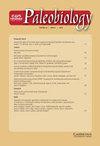底栖有孔虫组合的空间异质性追踪白垩纪OAE2古环境变化的区域影响
IF 2.6
2区 地球科学
Q2 BIODIVERSITY CONSERVATION
引用次数: 2
摘要
摘要。——全球气候事件对当地生态系统的影响可能在空间上有所不同。了解这种潜在的异质性可以阐明哪些环境将受到最大的影响,以及生态系统反应的近端驱动因素。西部内陆航道(WIS)的Cenomanian-Turonian海洋沉积物记录了与Greenhorn海侵和海洋缺氧事件2(OAE2)的发生有关的古海洋学变化。它们为研究全球扰动期间全流域的古生态响应提供了理想的环境。在这里,我们通过多元排序分析整合了OAE2之前、期间和之后的底栖有孔虫组合,以在共同的尺度上检查美国西部动物群反应的空间模式,并询问了以前定义的通常用于全流域相关性的动物群标记,即Benthonic Zone(BZ)。我们确定氧合和有机质质量是10个地层记录中动物群变化的主要和次要控制因素,并利用这种变化来推断古环境变化。与之前的研究相比,地层趋势显示OAE2发病时的脱氧作用。它们还揭示了氧合和生产力的时间模式,与南部水团逐渐向北迁移到WIS一致。这种空间异质性阻碍了BZ作为时间标记的使用,因为组合会随着跨时环境变化而变化,因此BZ相对于OAE2的时间在整个盆地中并不一致。我们的研究表明,区域过程可能会掩盖生态系统对全球事件的反应,并强调了考虑水团位置变化如何影响全球生物地球化学扰动表达的重要性。本文章由计算机程序翻译,如有差异,请以英文原文为准。
Spatial heterogeneity in benthic foraminiferal assemblages tracks regional impacts of paleoenvironmental change across Cretaceous OAE2
Abstract.— The impact of global climate events on local ecosystems can vary spatially. Understanding this potential heterogeneity can illuminate which environments will be most impacted and the proximal drivers of ecosystem responses. Cenomanian–Turonian marine deposits of the Western Interior Seaway (WIS) record paleoceanographic changes associated with the Greenhorn transgression and the onset of Oceanic Anoxic Event 2 (OAE2). They provide an ideal setting to study basin-wide paleoecological responses during a global perturbation. Here, we integrate benthic foraminiferal assemblages from before, during, and after OAE2 via multivariate ordination analysis to examine spatial patterns in faunal responses across the western United States on a common scale and to interrogate a previously defined faunal marker commonly used for basin-wide correlation, the Benthonic Zone (BZ). We identify oxygenation and organic matter quality as primary and secondary controls of faunal variation across the 10 stratigraphic records and use this variation to infer paleoenvironmental changes. Stratigraphic trends reveal, in contrast to previous studies, deoxygenation at the onset of OAE2. They also reveal temporal patterns in oxygenation and productivity consistent with the gradual northward migration of a southern water mass into the WIS. This spatial heterogeneity hinders the use of the BZ as a temporal marker, because assemblages change in response to diachronous environmental change, and thus timing of the BZ with respect to OAE2 is not consistent across the basin. Our study demonstrates that regional processes can overshadow ecosystem responses to global events and underscores the importance of considering how changes in the position of water masses impact the expression of global biogeochemical perturbations.
求助全文
通过发布文献求助,成功后即可免费获取论文全文。
去求助
来源期刊

Paleobiology
地学-古生物学
CiteScore
5.30
自引率
3.70%
发文量
38
审稿时长
>12 weeks
期刊介绍:
Paleobiology publishes original contributions of any length (but normally 10-50 manuscript pages) dealing with any aspect of biological paleontology. Emphasis is placed on biological or paleobiological processes and patterns, including macroevolution, extinction, diversification, speciation, functional morphology, bio-geography, phylogeny, paleoecology, molecular paleontology, taphonomy, natural selection and patterns of variation, abundance, and distribution in space and time, among others. Taxonomic papers are welcome if they have significant and broad applications. Papers concerning research on recent organisms and systems are appropriate if they are of particular interest to paleontologists. Papers should typically interest readers from more than one specialty. Proposals for symposium volumes should be discussed in advance with the editors.
 求助内容:
求助内容: 应助结果提醒方式:
应助结果提醒方式:


